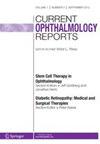直接颈动脉-海绵窦瘘的鉴别诊断特点。临床病例
IF 0.8
Q4 OPHTHALMOLOGY
引用次数: 0
摘要
创伤性脑损伤可引起眼球和颅腔内的各种病理状况。本病例具有直接颈动脉-海绵窦瘘与继发性创伤后青光眼的鉴别诊断特点。直接颈内动脉-海绵窦瘘是颈内动脉与海绵窦之间形成的通道,并将动脉血排出其中。颈动脉海绵状瘘管的第一个症状是头部和眼睛上方有搏动的噪音。临床表现为眼球及眼眶静脉流出受阻的征象:眼球突出、眼睑水肿及化脓、充血红肿、眼睑皮下静脉曲张、眼眶超声显示眼静脉扩张、眼压增高、动眼力障碍、眼底状况。继发性创伤后挫伤青光眼患者的临床表现除了眼压升高外,还表现为眼睛充血发红,角膜从轻度浅表性混浊变为更致密的混浊,晶状体脱位或半脱位进入前房或玻璃体,玻璃体破坏或眼内出血。外伤性颈动脉海绵窦瘘与继发性外伤性青光眼临床表现相似,给鉴别诊断带来困难。本文章由计算机程序翻译,如有差异,请以英文原文为准。
Features of differential diagnosis of direct carotid-cavernous fistula. Clinical case
Traumatic brain injury can cause various pathological conditions both in the eyeball and in the cranial cavity. The presented clinical case demonstrates the features of differential diagnosis of direct carotid-cavernous fistula and secondary post-traumatic glaucoma. Direct carotid-cavernous fistula is the formation of a communication between the internal carotid artery and the cavernous sinus and the discharge of arterial blood into it. The first symptom of a carotid-cavernous fistula is a pulsating noise in the head and above the eye. The manifest signs in the clinical picture are the signs of obstruction of venous outflow from the eye and the orbit: proptosis, eyelid edema and chemosis, congestive redness of the eye, varicose subcutaneous veins of the eyelids, as well as dilated ophthalmic vein visualized by ultrasound of the orbit, ophthalmic hypertension, oculomotor disorders, state of the fundus. The clinical picture in patients with secondary post-traumatic contusion glaucoma, in addition to an increase in intraocular pressure, is characterized by the presence of a congestive redness of the eye, changes in the cornea from mild superficial opacities to more dense ones, luxation or subluxation of the lens into the anterior chamber or vitreous, destruction of the vitreous or intraocular hemorrhage. The similarity of clinical manifestations of traumatic carotid-cavernous fistula and secondary post-traumatic glaucoma can cause difficulties in differential diagnosis.
求助全文
通过发布文献求助,成功后即可免费获取论文全文。
去求助
来源期刊

Current Ophthalmology Reports
Medicine-Ophthalmology
CiteScore
2.00
自引率
0.00%
发文量
22
期刊介绍:
This journal aims to offer expert review articles on the most significant recent developments in the field of ophthalmology. By providing clear, insightful, balanced contributions, the journal intends to serve those who diagnose, treat, manage, and prevent ocular conditions and diseases. We accomplish this aim by appointing international authorities to serve as Section Editors in key subject areas across the field. Section Editors select topics for which leading experts contribute comprehensive review articles that emphasize new developments and recently published papers of major importance, highlighted by annotated reference lists. An Editorial Board of more than 20 internationally diverse members reviews the annual table of contents, ensures that topics include emerging research, and suggests topics of special importance to their country/region. Topics covered may include age-related macular degeneration; diabetic retinopathy; dry eye syndrome; glaucoma; pediatric ophthalmology; ocular infections; refractive surgery; and stem cell therapy.
 求助内容:
求助内容: 应助结果提醒方式:
应助结果提醒方式:


